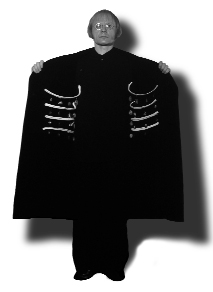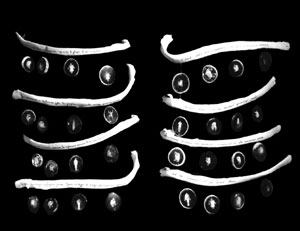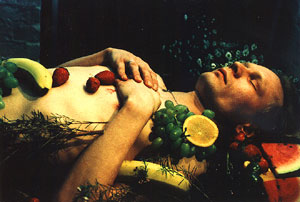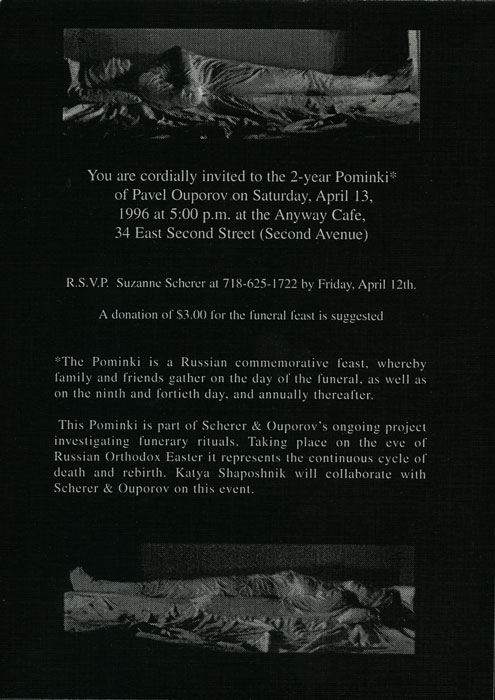
DREVO
Scherer
& Ouporov, 1997-2003
Drevo,
at Gallery Palto and COFA
Drevo/Palto, 2002, is a re-creation of a 1997 performance and site specific sculpture. In the manner of Joseph Beuys, the artist functions as both architecture and shaman. Drevo, a symbol of an ancient tree, consists of human rib bones and photos of naked figures--animalistic and alone--mounted on sliced cow horn.Scrawled across the rib cage is a poem by the Russian Futurist poet Velemir Khlebnikov, Numbers, which reveals a blend of Platonic philosophy and shamanic conciousness:
I see right through you, Numbers.
I see you dressed in animals, their skins,
coolly propped against uprooted oaks.
You offer us a gifts unity between the snaky movement
of the backbone of the universe and Libra dancing
overhead.? You help us to see centuries as a flash
of laughing teeth.See my wisdom-wizened eyes
opening to recognize
what my I
will be
when its dividend is one.
The sliced cow horn represents the dismemberment or cutting to pieces of the shamanic process, while the constructed tree/rib cage serves as a metaphor of the mystical reconstruction. As with the Siberian shaman, the transformation is complete once the coat is put on.

Scherer
& Ouporov, Drevo/Tree, 27 x 35 cm (each side), human
rib bones, cow horns, photos, resin, 1997-2002

The shamans of
Siberia make their ascents and descents to the spirit worlds
above and below in religious ecstasy and trance. Here, the shaman
Tulayev stands before his tent (yurt), holding his drum. It is
believed by many Siberian tribes that the frame of the shamans
drum is made from the wood of the great World Tree which stands
on an island or a mountain at the centre of the world. This relationship
between the Tree and the drum is extremely significant, for it
is through his drumming that the shaman induces the religious
ecstasy that enables him to enter the trance state and ascend
through the centre to the spirit world. His spiritual vocation
first manifests itself quite involuntarily, in the form of spontaneous
dreams and visions, during which he is initiated by the spirits
of the other world. This consists, in part of being cut to pieces
and reduced to a skeleton, then mystically remade from the bones
which represent the indestrucible essence of life. As a sign
that he has undergone this process, the shaman here wears the
skeletal structure of his rib cage appliqued to his chest. This
is sewn on with the white throat hairs of the reindeer, the sacred
thread used for all ritual embroideries. Altogether the shamans
costume is extremely sacred, for as he puts it on he is in contact
with the spirits of the other world, because the costume which
is decorated with their symbols is impregnated by their power.
(Karagass
shaman, Siberia, photographed by Petri, c. 1927.)1
1Roger Cook, The Tree of Life, (New York Thames and Hudson, 1974), 116.


Scherer
& Ouporov, 1996, Pominki, New York, part of an ongoing
performance
photo
credit: Luba Proger
Scherer & Ouporov, 1997, Out of the Fire & Into the Frying Pan, New York, part of an ongoing performance photo credit: Mark Kopelev